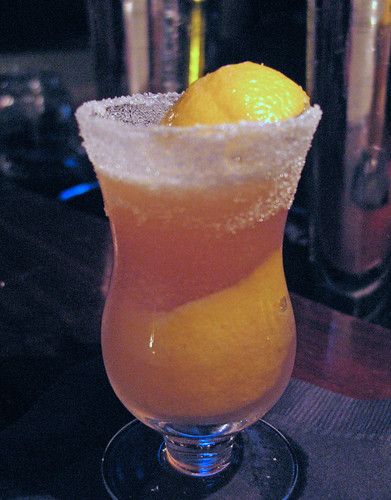The Gypsy Cocktail, or Saying Nice Things About Vodka
Saying nice things about vodka? Heaven forfend.
It’s true, vodka doesn’t get a lot of respect from bartenders these days. It’s true, vodka is responsible for what one of my BarSmarts teachers called “The Era of the Fear of Flavor,” when vodka sales overtook gin sales in the late 1950s, and whiskey sales in the mid-1960s. Yes, it’s the base of a lot of lazy juice drinks, and all those Vodka Tonics we shake our heads to see turned out by the hundreds to people who apparently don’t want to taste much of anything, but want to get lit.
But where would a Moscow Mule be without vodka? I love Moscow Mules.
Vodka provides a bridge between the flavors of gin and Kina Lillet in the original Vesper cocktail.
Vodka in your Bloody Mary, baby. (Although I prefer gin, unsurprisingly.)
Truth is there are plenty of things you can do with vodka, if you use it wisely (i.e., not in something called a “Vodka Martini,” of which there is no such thing). Vodka can be used to round out the flavor of an intense or sweet ingredient, softening it while still maintaining it. A prime example of this comes from David Wondrich, via his first book Esquire Drinks: An Opinionated & Irreverent Guide to Drinking. He introduced me to a cocktail in which vodka is seemingly its base spirit but the true flavor of the cocktail is really based on a liqueur (by David Embury’s formula, something thought of as a modifier).
Bénédictine is a delicious, spicy herbal liqueur and one of my very favorites, but it’s also very sweet. I’m not big on really sweet drinks, and I rarely if ever sip liqueurs alone. This is a great way to enjoy the flavor of Bénédictine while keeping the sweetness in check. The dash of bitters helps bring it all together.
Make sure you use real Bénédictine and not “B&B,” which is a bottled mixture of half Bénédictine and half brandy.
The Gypsy Cocktail
2 ounces vodka.
1 ounce Bénédictine D.O.M. liqueur.
1 dash Angostura bitters.Stir for no less than 30 seconds. Strain into a chilled cocktail glass.
This is actually quite nice. Dave says that you can make this with any “funky, herbal” European liqueur, such as Chartreuse, but he prefers this combination.
One of the very first really great cocktail books I picked up about 10 years ago was Paul Harrington’s Cocktail: The Drinks Bible for the 21st Century. In it is an original of his which he called “The Drink Without A Name,” renamed by Robert Hess as The Harrington Cocktail (a much better name, I think). It’s almost entirely vodka, with small amounts of two liqueurs to provide subtle but pronounced flavors. It’s very good (but becuase I can’t help it I’ve made it with gin, and it’s really good with that too, especially with Old Tom).
Vodka is also great for preserving homemade syrups, making spice and herb tinctures, and the like. Your bar is incomplete without it.
Now, that said, there’s really no reason for you to spend a lot of money on “premium” vodka unless you are a vodka connoisseur and enjoy sipping them chilled and neat. Those who enjoy that can discern subtle differences in vodkas based on what they’re made of (wheat, rye, potatoes, grapes, etc.), although that’s not my thing. However, once you put that in a drink all those subtleties disappear.
The best value in vodka on the market right now is Sobieski, from Poland. It wins blind taste tests left and right against vodkas costing five or more times its price, which is about $11 a bottle. It’s worth seeking out.






